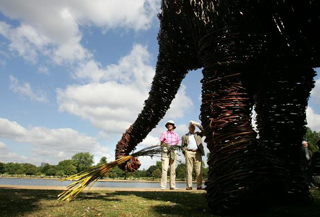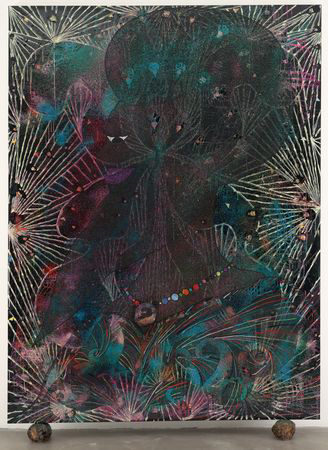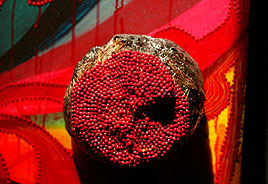Human Flower Project
Wednesday, September 05, 2007
Gung-Ho for Elephant Dung
The ideal garden fortifier puts on a really big fine art show.

A willow and steel sculpture (and dung in nearby flower beds) alert Londoners to support elephant conservation.
Photo: Cate Gillon, for Getty Images
We’ve tried composted turkey, hog, horse and cow droppings in the garden—all with success. But we learn from manure-ologist Marion Owen that the dandiest doo is elephant dung. An exhibit of elephant sculptures now on display in London’s Hyde Park inspired our dung hunt. A wildlife charity commissioned the willow and steel sculptures to raise money for elephant conservation projects. “Steve Manning, a topiary artist, and Joe Crane, a willow technician, took six months to create the herd at workshops in Pakenham, Suffolk.
 Wyche’s Yellow Tomatoes
Wyche’s Yellow Tomatoes
developed in elephant-fortified soil
Photo:
“ title=” solan seeds”>Solan Seeds
“Half a ton of elephant dung will be used to fertilize flower beds at the site,” according to the BBC. Sounds like a lot, but according to one source, an adult elephant produces 500 pounds of dung a day. Dr. John Wyche, who owned Cole Brothers Circus, used elephant manure with great aplomb on his garden in Hugo, Oklahoma. Among his achievements was Wychie’s Yellow Tomato.
For the gardener who has everything, the National Zoo in Washington, D.C. sells “Zoo Doo”—produced by the Smithsonian’s elephants in residence. Apparently, it doesn’t generate much money for the zoo but has been a public relations bonanza. Outside the Beltway—on other continent—elephant dung is used as a mosquito repellant. Now THAT we could use around Austin (we wonder if cow poop, a lot more plentiful in these parts, works as well?).
 Prince Among Thieves
Prince Among Thieves
by Chris Olifi, 1990
Collection: Museum of Modern Art
In our quest to connect flower cultures back to the rest of life, we must tip our trunk to Chris Olifi, the English artist who made a name for himself using elephant dung in multi-media works. It was Olifi who scandalized then-New York-mayor Rudy Giuliani by including elephant dung—among other surprising elements—in his portrait of the Virgin Mary back in 1999, a piece the Brooklyn Museum included in its Sensation show. Olifi apparently discovered the sculptural qualities of this material while traveling in Africa and has since made piles and oversize “beads” of dung his signature.
Since he made it big, so to speak, Olifi has donated generously to the Zoological Society of London. “It would be impossible for me to create my paintings without the elephants,” said Olifi. “It has been a rare honour and opportunity to get to know Mya, Layang-Layang and Dilberta.”
 The Upper Room (detail)
The Upper Room (detail)
by Chris Olifi, 2005
Photo: Roger Taylor
For more information on how to use more mundane kinds of manure in your own garden, check out this source on composting and here’s another. It all seems pretty straightforward!
The only proviso seems to be that shoveling fresh poop straight on your garden can burn plants. It’s safer to mix manure with the leaves and vegetable trimmings in your compost pile and let it all “cook” awhile. Marion Owen recommends “all animal manure should be aged for at least 6 months. Many gardeners spread fresh manure in the fall and turn it in to the top 6 inches of soil a month before spring planting.”
It’s about that time.




